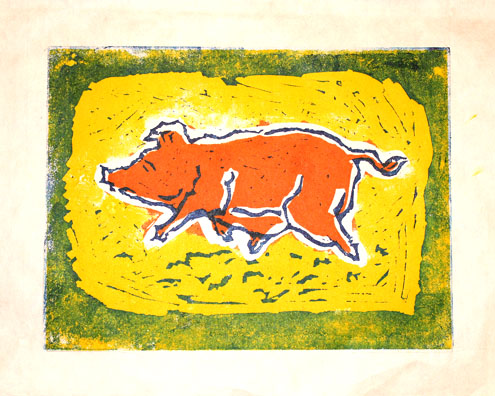Pig - Linoleum Block Print

Amongst the more affordable items of the - quote - "fine arts" - unquote - are block prints. Traditionally the printing surfaces were carved into wooden blocks. But today - although wood is still used a a lot - linoleum - for making linocuts - has become a popular substitute.
Now we don't mean to claim that all block prints are cheap. Today Picasso linocuts can run for (easily) tens of thousands of dollars. But once upon a time a Pablo print fit the budget of even the most genteel of the genteel middle class. And the prints of the Japanese master Hokusai Katsushika were originally intended to decorate every Japanese home. When he put them up for sale, a print of his Wave cost about the same as a bowl of noodles. Of course, if you can find an original for sale today, rest assured you can buy a lot of noodles for what you'll pay.
Again what may shock! shock! the buying public is that not all of the print artists either carve their own blocks or run off the editions. Instead they hire - yes hire - specialists for the job. For instance Hokusai would make his painting and then turn it over to skilled block carvers. And the block prints used to illustrate the original editions of Alice in Wonderland were by the British artist John Tenniel. He would make the drawing on the block (using a pencil) and then hand it over to the wood engravers (not exactly the same as wood block carvers). John - or his publishers - preferred the Dalziel brothers, George and Edward and their family owned firm. As anyone knows who has seen the blocks themselves, the Dalziel's were extremely skilled and it is quite an omission to neglect their contributions to the artistry of the final prints. That said, many artist do the carving and printing themselves.
But the number one reason block prints are reasonably affordable is that the are printed in "editions". That is, there is more than one print made. You can also print more if you run out although it is considered a bit gauche to go beyond the maximum number indicated on the margins.
Another factor that keeps the prices down is that the materials themselves are cheap and simple, at least as far as art materials and equipment goes. With such simplicity of materials, you can also make the art - the blocks and the prints - in the privacy of your own home. Sadly that is not the case with etchings - which often require dangerous chemicals - or with lithographs - traditionally printed from limestone blocks by a complicated process which also requires chemicals not recommended to be handled by untrained. Finally, both etchings and lithographs require specialized presses which run from hundreds to tens of thousands of dollars.
Block printing, on the other hand, needs must have you simply (?) cut the image into the block, ink it, and make the print. Although presses can be used, many master block printers eschew them altogether. In one particularly well-equipped art school, the print department has six lithograph presses, four etching presses, but only one block press. Instead, the block prints are mostly made by just hand pressure using a wooden rice spoon that has been sanded so the back of the spoon is flat. With the proper paper - usually thinner than used for etching or lithographs - you can make surprisingly good prints. The spoon also gives you a lot of flexibility on applying the pressure and how to render the final print.
Color can be added in a number of ways. You can add colors after printing but that's cheating a bit. Instead a true color print will add color as part of the printing process. Although you can put different colors on different parts of one block, it's also common to have each color on a separate block. Of course you have to take care to align - that is, to "register" - the paper carefully on each block before "pulling" the print.
In the print shown above there were just two blocks. The orange and yellow were on one block and the lines and border on another. There was, by the way, no green ink used. The lines and border were inked in blue which blended with the yellow to form the green. The actual technique for making sure the different blocks have the areas for each color in the right places is a bit involved and may be the subject of a future essay.
.